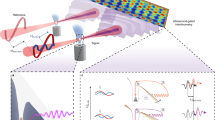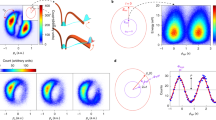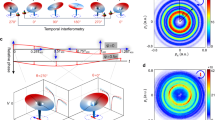Abstract
Recent measurements of time delays during tunnelling of cold atoms through an optically created potential barrier have fuelled an ongoing debate about possible time delays during light-induced tunnelling of an electron from an atom. Yet, such a delay—whether it is present or not—is only one quantity characterizing the tunnelling wavepacket, whilst the underlying dynamics are richer. Here we show how to complement photo-electron detection in laser-induced tunnelling by measuring the light emitted by the tunnelling electron—the so-called Brunel radiation. Using a combination of single- and two-colour driving fields, we identify the all-optical signatures of the reshaping of the tunnelling wavepacket as it emerges from the tunnelling barrier and moves away from the core. This reshaping includes not only an effective time delay but also the time-reversal asymmetry of the ionization process, which we describe theoretically and observe experimentally. We show how both delay and reshaping are mapped onto the polarization properties of the Brunel radiation, with different harmonics behaving as different hands of a clock moving at different speeds. The all-optical detection may also allow time-resolved measurements of optical tunnelling in condensed matter systems on the attosecond time scale.
This is a preview of subscription content, access via your institution
Access options
Access Nature and 54 other Nature Portfolio journals
Get Nature+, our best-value online-access subscription
$29.99 / 30 days
cancel any time
Subscribe to this journal
Receive 12 print issues and online access
$209.00 per year
only $17.42 per issue
Buy this article
- Purchase on Springer Link
- Instant access to full article PDF
Prices may be subject to local taxes which are calculated during checkout



Similar content being viewed by others
Data availability
Source data are available for this paper. All other data that support the plots within this paper and other findings of this study are available from the corresponding author upon reasonable request. Source data are provided with this paper.
References
Corkum, P. B. & Krausz, F. Attosecond science. Nat. Phys. 3, 381 (2007).
Baker, S. et al. Probing proton dynamics in molecules on an attosecond time scale. Science 312, 424 (2006).
Smirnova, O. et al. High harmonic interferometry of multi-electron dynamics in molecules. Nature 460, 972 (2009).
Bruner, B. D. et al. Multidimensional high harmonic spectroscopy. J. Phys. B 48, 174006 (2015).
Torres, R. et al. Revealing molecular structure and dynamics through high-order harmonic generation driven by mid-IR fields. Phys. Rev. A 81, 051802 (2010).
Pedatzur, O. et al. Attosecond tunnelling interferometry. Nat. Phys. 11, 815 (2015).
Brunel, F. Harmonic generation due to plasma effects in a gas undergoing multiphoton ionization in the high-intensity limit. J. Opt. Soc. Am. B 7, 521 (1990).
Babushkin, I. et al. Terahertz and higher-order Brunel harmonics: from tunnel to multiphoton ionization regime in tailored fields. J. Mod. Opt. 64, 1078 (2017).
Balciunas, T. et al. Optical and THz signatures of sub-cycle tunneling dynamics. Chem. Phys. 414, 92 (2013).
Lanin, A. A., Stepanov, E. A., Fedotov, A. B. & Zheltikov, A. M. Mapping the electron band structure by intraband high-harmonic generation in solids. Optica 4, 516 (2017).
Silva, R. E. F., Jiménez-Galán, Á., Amorim, B., Smirnova, O. & Ivanov, M. Topological strong-field physics on sub-laser-cycle timescale. Nat. Photonics 13, 849 (2019).
Jürgens, P. et al. Origin of strong-field-induced low-order harmonic generation in amorphous quartz. Nat. Phys. 16, 1035 (2020).
Jürgens, P. et al. Characterization of laser-induced ionization dynamics in solid dielectrics. arXiv https://arxiv.org/abs/2108.03053 (2021).
Kim, K. Y., Taylor, A. J., Glownia, J. H. & Rodriguez, G. Coherent control of terahertz supercontinuum generation in ultrafast laser–gas interactions. Nat. Photonics 2, 605 (2008).
Babushkin, I. et al. Tailoring terahertz radiation by controlling tunnel photoionization events in gases. New J. Phys 13, 123029 (2011).
Geissler, M. et al. Light propagation in field-ionizing media: extreme nonlinear optics. Phys. Rev. Lett. 83, 2930 (1999).
Babushkin, I., Skupin, S. & Herrmann, J. Generation of terahertz radiation from ionizing two-color laser pulses in Ar filled metallic hollow waveguides. Opt. Express 18, 9658 (2010).
Zhang, K. et al. Continuum electron giving birth to terahertz emission. Photonics Res. 8, 760 (2020).
Eckle, P. et al. Attosecond angular streaking. Nat. Phys. 4, 565 (2008a).
Eckle, P. et al. Attosecond ionization and tunneling delay time measurements in helium. Science 322, 1525 (2008b).
Huismans, Y. et al. Time-resolved holography with photoelectrons. Science 331, 61 (2011).
Shafir, D. et al. Resolving the time when an electron exits a tunnelling barrier. Nature 485, 343 (2012).
Kienberger, R. et al. Atomic transient recorder. Nature 427, 817 (2004).
Pfeiffer, A. N. et al. Attoclock reveals natural coordinates of the laser-induced tunnelling current flow in atoms. Nat. Phys. 8, 76 (2011).
Landsman, A. S. Ultrafast resolution of tunneling delay time. Optica 1, 343 (2014).
Yakaboylu, E., Klaiber, M. & Hatsagortsyan, K. Z. Wigner time delay for tunneling ionization via the electron propagator. Phys. Rev. A 90, 012116 (2014).
Torlina, L. et al. Interpreting attoclock measurements of tunnelling times. Nat. Phys. 11, 503 (2015).
Ni, H., Saalmann, U. & Rost, J.-M. Tunneling ionization time resolved by backpropagation. Phys. Rev. Lett. 117, 023002 (2016).
Camus, N. et al. Experimental evidence for quantum tunneling time. Phys. Rev. Lett. 119, 023201 (2017).
Sainadh, U. S. et al. Attosecond angular streaking and tunnelling time in atomic hydrogen. Nature 568, 75 (2019).
Eicke, N., Brennecke, S. & Lein, M. Attosecond-scale streaking methods for strong-field ionization by tailored fields. Phys. Rev. Let. 124, 043202 (2020).
Ivanov, I. A. & Kheifets, A. S. Strong-field ionization of He by elliptically polarized light in attoclock configuration. Phys. Rev. A 89, 021402 (2014).
Landsman, A. S. & Keller, U. Attosecond science and the tunnelling time problem. Phys. Rep. 547, 1 (2015).
Teeny, N., Yakaboylu, E., Bauke, H. & Keitel, C. H. Ionization time and exit momentum in strong-field tunnel ionization. Phys. Rev. Lett. 116, 063003 (2016).
Kaushal, J., Morales, F., Torlina, L., Ivanov, M. & Smirnova, O. Spin-orbit larmor clock for ionization times in one-photon and strong-field regimes. J. Phys. B 48, 234002 (2015).
Eicke, N. & Lein, M. Attoclock with counter-rotating bicircular laser fields. Phys. Rev. A 99, 031402 (2019).
Ramos, R., Spierings, D., Racicot, I. & Steinberg, A. Measurement of the time spent by a tunnelling atom within the barrier region. Nature 583, 529 (2020).
Meng, C. et al. Enhancement of terahertz radiation by using circularly polarized two-color laser fields. Appl. Phys. Lett. 109, 131105 (2016).
Tulsky, V. A., Baghery, M., Saalmann, U. & Popruzhenko, S. V. Boosting terahertz-radiation power with two-color circularly polarized midinfrared laser pulses. Phys. Rev. A 98, 053415 (2018).
Tailliez, C. et al. Terahertz pulse generation by two-color laser fields with circular polarization. New J. Phys. 22, 103038 (2020).
Yudin, G. L. & Ivanov, M. Y. Nonadiabatic tunnel ionization: looking inside a laser cycle. Phys. Rev. A 64, 013409 (2001a).
Kim, K.-Y. Generation of coherent terahertz radiation in ultrafast laser–gas interactions. Phys. Plasmas 16, 056706 (2009).
Torlina, L. & Smirnova, O. Time-dependent analytical R-matrix approach for strong-field dynamics. I. one-electron systems. Phys. Rev. A 86, 043408 (2012).
Bruner, B. D. et al. Multidimensional high harmonic spectroscopy of polyatomic molecules: detecting sub-cycle laser-driven hole dynamics upon ionization in strong mid-IR laser fields. Faraday Discuss. 194, 369 (2016).
Ivanov, M. Y., Spanner, M. & Smirnova, O. Anatomy of strong field ionization. J. Mod. Opt. 52, 165 (2005).
Hofmann, M. et al. Noninstantaneous polarization dynamics in dielectric media. Optica 2, 151 (2015).
Sommer, A. et al. Attosecond nonlinear polarization and light–matter energy transfer in solids. Nature 534, 86 (2016).
Hassan, M. T. et al. Optical attosecond pulses and tracking the nonlinear response of bound electrons. Nature 530, 66 (2016).
Morales, F., Bredtmann, T. & Patchkovskii, S. iSURF: a family of infinite-time surface flux methods. J. Phys. B: At. Mol. Opt. Phys. 49, 245001 (2016).
Yudin, G. L. & Ivanov, M. Y. Nonadiabatic tunnel ionization: looking inside a laser cycle. Phys. Rev. A 64, 013409 (2001b).
Acknowledgements
I.B., A.D. and U.M. thank the Deutsche Forschungsgemeinschaft (DFG) (projects BA 4156/4-2, MO 850-19/2) as well as the Cluster of Excellence PhoenixD (EXC 2122, project ID 390833453) for financial support. O.G.K., I.A.N., N.A.P. and D.E.S. thank the Russian Science Foundation (grant no. 21-49-00023) and National Natural Science Foundation of China (12061131010) for support. S.S. acknowledges support by the Qatar National Research Fund (grant NPRP 12S-0205-190047) and HPC resources from GENCI (grant no. A0080507594). Á.J.G. acknowledges funding from the European Union’s Horizon 2020 research and innovation programme under the Marie Skłodowska-Curie grant agreement no. 101028938. M.I. acknowledges support by the DFG priority programme QUTIF under grant agreement IV 152/6-2 and funding from the European Union’s Horizon 2020 research and innovation programme under grant agreement no 899794.
Author information
Authors and Affiliations
Contributions
I.B. suggested the idea, developed the quantum Drude-like model, performed simulations and analytics based on this model and performed TDSE simulations. Á.J.G. performed TDSE simulations for the two-colour case. S.S., O.G.K., I.A.N., N.A.P. and D.E.S. performed simulations of unidirectional propagation equations. J.R.C.d.A., M.K., D.Z. and L.S. performed the experiment. I.B., Á.J.G., A.H., F.M., L.B., S.S., U.M., A.D., T.N., M.J.J.V., V.V. and M.I. analysed and interpreted the results of the simulations and experiments. All authors participated in the article formulation and writing.
Corresponding author
Ethics declarations
Competing interests
The authors declare no competing interests.
Peer review
Peer review information
Nature Physics thanks the anonymous reviewers for their contribution to the peer review of this work
Additional information
Publisher’s note Springer Nature remains neutral with regard to jurisdictional claims in published maps and institutional affiliations.
Supplementary information
Supplementary
Supplementary discussion.
Rights and permissions
About this article
Cite this article
Babushkin, I., Galán, Á.J., de Andrade, J.R.C. et al. All-optical attoclock for imaging tunnelling wavepackets. Nat. Phys. 18, 417–422 (2022). https://doi.org/10.1038/s41567-022-01505-2
Received:
Accepted:
Published:
Issue Date:
DOI: https://doi.org/10.1038/s41567-022-01505-2
This article is cited by
-
Spatiotemporal imaging and shaping of electron wave functions using novel attoclock interferometry
Nature Communications (2024)



